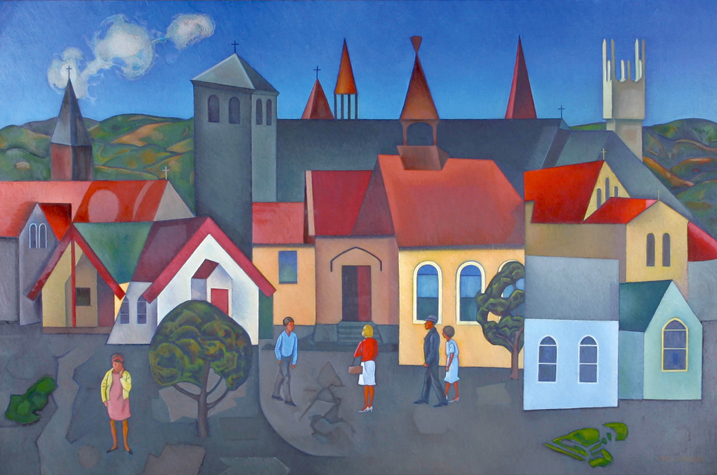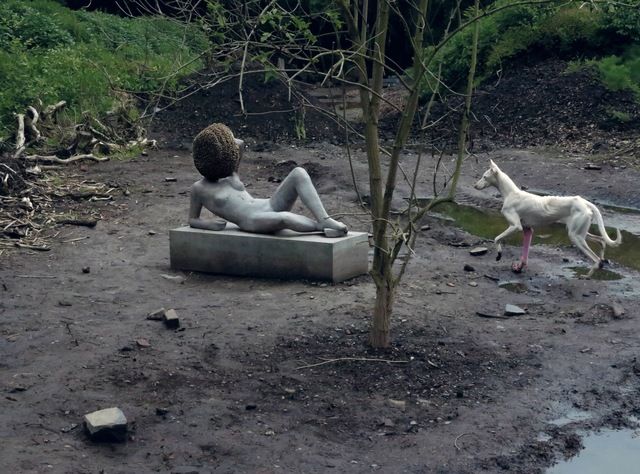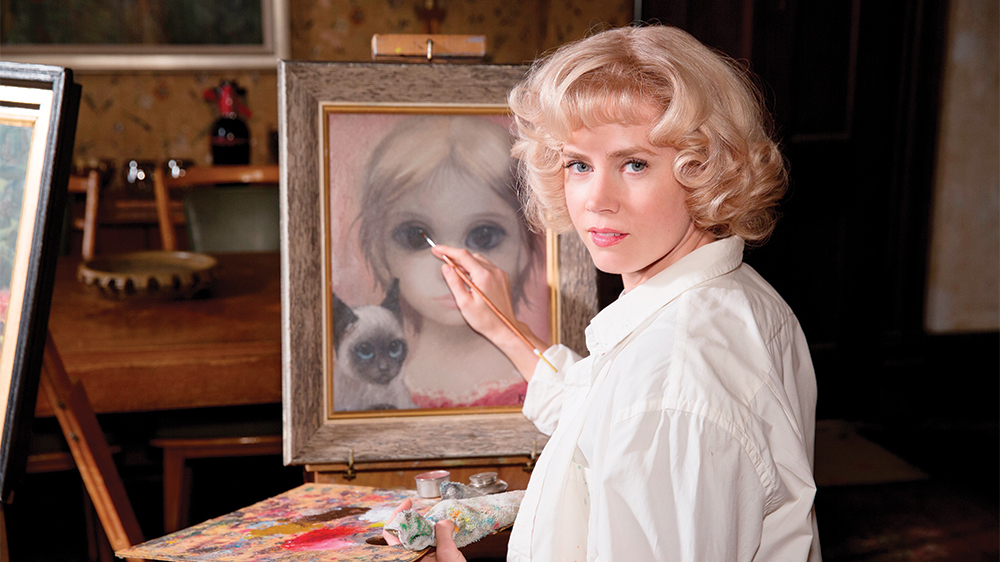.
It’s not one of Rita Angus’s great paintings, but I’ve always had a soft spot for Churches, Hawke’s Bay. ‘Church’ suggests congregation, a united community. But, in the painting, multiple churches are grafted together or emerge from one another haphazardly, suggesting competing views, schisms, a fractured community. One of the churches is a wharenui. As if to echo this doctrinal discord, there’s no ruling perspective at work in the painting. The artist looks at once to medieval painting (before Albertian perspective) and to cubism (its undoing). Faceless people are peppered about, looking somewhat awkward and isolated, like they don’t know where to turn in the visual and ideological clamour. Perhaps those eye-candy colours are deceptive. Is this a happy painting or a sad one—an image of community or alienation, utopia or dystopia? I don’t know.
.
[IMAGE: Rita Angus Churches, Hawke’s Bay 1962–3]
•


More than Human
.
Human thinking has generally been human-centric, drawing a line between consciousness and the world, humans and everything else. That’s why animals are so perplexing for us, because we don’t know which side of the line to put them on, whether to relate to them as other sentient beings like us or as objects for us. Art has emphasised this human-centric approach, locating artists (and, by analogy, their viewers) at the sovereign centre of the world, with things arrayed for their (and our) benefit, addressed to them (and us). We have learnt to take this approach for granted. So, for me, it was profoundly disorienting to see Pierre Huyghe’s project Untilled in Documenta 13 in Kassel, Germany, back in 2012. A game changing moment.
Untilled occupied an out-of-the-way location—a dowdy area where one was not expected to go—at the edge of the otherwise scenic Karlsaue Park. I entered via a beaten track, passing piles of compost and algae-covered puddles. The site was overgrown with plants, including psychotropic, medical, and aphrodisiac ones (cannabis, deadly nightshade, and angel’s trumpets). Concrete paving slabs were stacked up matter of factly, as if waiting to be deployed elsewhere. The apparent centrepiece was a conventional sculpture of a female nude on a plinth—a replica of a 1930s work by Max Weber. But, by the time I arrived, the head had been replaced—or colonised—by a hive of bees. A greyhound called Human, with one leg painted pink, wandered around freely. Many obscure reference points—including nods to Huysmans’s novel À Rebours and Raymond Roussel’s novel Locus Solus—were apparent only by reference to a drawing in the exhibition guidebook.
Untilled didn’t look like any artwork I had ever seen—it didn’t look like art full stop. Stuff was rotting; stuff was growing; stuff was interacting; stuff was waiting to be turned into something else somewhere else. Potential was everywhere. There was no clear frame to show where the work started and stopped. It was hard to know what was in or out, what was significant and what was incidental, what had been found and what had been added by the artist. Not only was the work not addressed to me, it incorporated flora and fauna with lives and purposes of their own, engaging with this scenario alongside me on their own terms. The work seemed free to evolve or devolve, beyond any artistic intention. There was no clear drama, no spectacle, yet the effect was uncanny, even menacing. I was reminded of The Zone in Tarkovsky’s film Stalker.
Only later did I come to appreciate the full significance of Untilled, as breaking from a human-centred perspective. It heralded a new approach to art making, with more art operating in this vein appearing in its wake. Today, knowing we have brought the planet to the brink ecologically, there’s an appetite for less-chauvinistic attitudes—orientations that deprioritise human perceptions and demands. This imperative informs new philosophical approaches, such as Graham Harman’s object-oriented ontology. In different ways, Zac Langdon-Pole and Simon Ingram—both currently showing at City Gallery—participate in this Zeitgeist. They adopt decentered approaches: Langdon-Pole collaging things to collide their disparate, often inhuman frames of reference (an octopus shell and a meteorite); Ingram by understanding the artist as just one node in the assemblage that produces the work. (Zac Langdon-Pole: Containing Multitudes and Simon Ingram: The Algorithmic Impulse, until 7 March 2021.)
.
[IMAGE: Pierre Huyghe Untilled 2012]
•

Art-Goes-to-the-Movies Quiz
.
Who played these real artists in the movies?
Rembrandt in Rembrandt (1936)
Paul Gauguin in Lust for Life (1956)
Vincent van Gogh in Lust for Life (1956)
Michelangelo in The Agony and the Ecstasy (1965)
Andrej Rublev in Andrej Rublev (1966)
Camille Claudel in Camille Claudel (1988)
Dora Carrington in Carrington (1995)
Jean-Michel Basquiat in Basquiat (1996)
Andy Warhol in Basquiat (1996)
Pablo Picasso in Surviving Picasso (1996)
Francis Bacon in Love Is the Devil (1998)
Willem de Kooning in Pollock (2000)
Lee Krasner in Pollock (2000)
Jackson Pollock in Pollock (2000)
Frida Kahlo in Frida (2002)
Johannes Vermeer in The Girl in the Pearl Earring (2003)
Amedeo Modigliani in Modigliani (2004)
Diane Arbus in Fur (2006)
Margaret Keane in Big Eyes (2014)
J.M.W. Turner in Mr Turner (2014)
Alberto Giacometti in Final Portrait (2017)
Vincent Van Gogh in At Eternity’s Gate (2018)
J.S. Lowry in Mrs Lowry and Son (2019)
.
Answers here.
.
[IMAGE: dir. Tim Burton Big Eyes 2014]
•
Who Am I?
I am a contemporary-art curator and writer, and Director of the Institute of Modern Art, Brisbane. I have held curatorial posts at Wellington’s National Art Gallery, New Plymouth’s Govett-Brewster Art Gallery, Dunedin Public Art Gallery, Auckland Art Gallery, and, most recently, City Gallery Wellington, and directed Auckland’s Artspace. My shows include Headlands: Thinking through New Zealand Art for Sydney’s Museum of Contemporary Art (1992); Action Replay: Post-Object Art for Artspace, Govett-Brewster Art Gallery, and Auckland Art Gallery (1998); and Mixed-Up Childhood for Auckland Art Gallery (2005). My City Gallery shows include Yvonne Todd: Creamy Psychology (2014), Julian Dashper & Friends (2015), Francis Upritchard: Jealous Saboteurs (2016), Colin McCahon: On Going Out with the Tide (2017), John Stezaker: Lost World (2017), This Is New Zealand (2018), Iconography of Revolt (2018), Semiconductor: The Technological Sublime (2019), Oracles (2020), Zac Langdon-Pole: Containing Multitudes (2020), and Judy Millar: Action Movie (2021). I curated New Zealand representation for Brisbane’s Asia-Pacific Triennial in 1999, the Sao Paulo Biennale in 2002, and the Venice Biennale in 2003 and 2015. I am co-publisher of the imprint Bouncy Castle.
Contact
BouncyCastleLeonard@gmail.com
+61 452252414
This Website
I made this website to offer easy access to my writings. Texts have been edited and tweaked. Where I’ve found mistakes, I’ve corrected them.
.